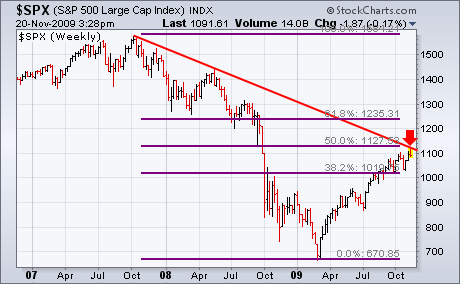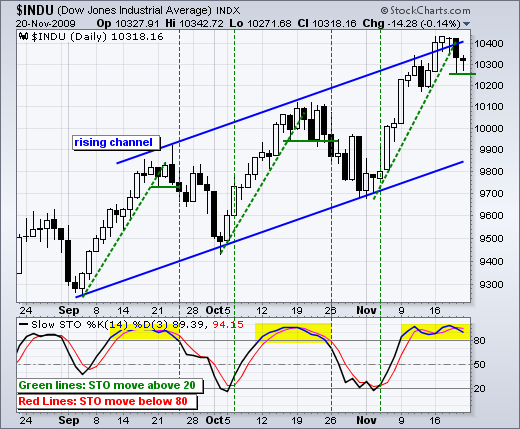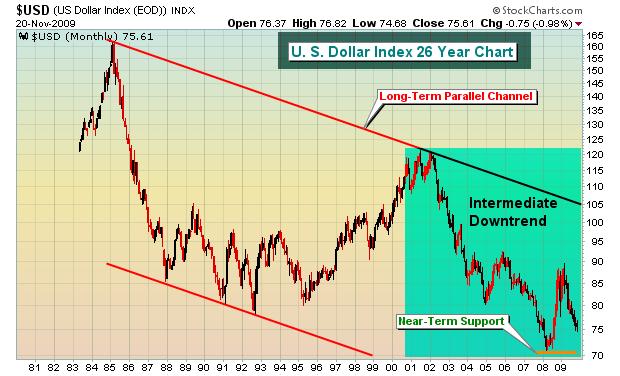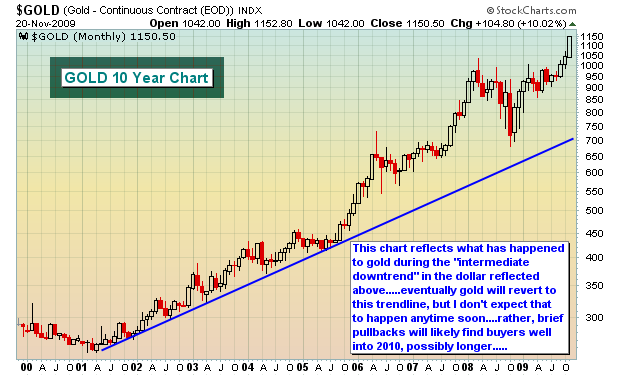Hello Fellow ChartWatchers!
I have two big announcements for you this time around:
OUR HOLIDAY SPECIAL IS NOW ON!
With the holiday season just around the corner, we've fired up our Holiday Special. It's a great way for you to join up or extend your StockCharts.com account at the lowest possible cost. Here's how it works:
- Sign up for 6 months of any of our services and receive ONE ADDITIONAL MONTH FOR FREE.
OR
- Sign up for 12 months of any service and receive TWO additional months for free.
To get started, just visit our Service page, determine which service level you'd like, and click the "Sign Up Now!" button.
Are you already a member? No worries - just extend your current membership by 6 or 12 months to get this same special deal. It doesn't matter if your account expires next month or next year, you can still renew now to get this special pricing.
(BTW, if you recently renewed and are worried that you missed out on this special, check your renewal carefully - you probably got the additional free month without realizing it. We're sneaky that way.)
ANNOUNCING A NEW REWARDS PROGRAM!
If you've been a member of StockCharts.com for more than a year, you now qualify for our long-term loyalty discount! Here's how it works:
If you've been a continuous member for more than a year, you should now see a yellow "badge" or ribbon after your name on our "Members" page after you log in. (Market Message-only subscribers will see it on the right side of the Market Message page.) Your badge should look similar to this:
If you click on that badge, you should see a popup window appear that contains a Coupon Code. That code, which is unique to your account and cannot be shared, can be used to reduce the cost of any renewal or upgrade order. The amount of the reduction depends on how long you have been a member.
To use the coupon, you simply write it down and enter it into the "Coupon" field at the end of our sign-up process.
Coupon codes can only be used once, however, going forward, for each year that you are a member, you will receive an additional coupon with a larger discount.
And YES, you can combine your coupon code with our Holiday Special to lower the cost of your subscription even more! (However, you can also save your coupon code for later if you want - it doesn't expire.)
(By the way, if your StockCharts.com account has recently expired, watch your email box this week for a message with a special re-subscription coupon code.)
This is just our way of saying Happy Holidays and THANK YOU to all of our loyal, long-time subscribers!
- Chip
The following three charts show the three major U.S. stock indexes having
reached formidable overhead resistance barriers. Charts 1 and 2 show
the Dow Industrials and the S&P 500
having retraced 50% of their bear market declines. More importantly,
both indexes are testing major down trendlines drawn over 2007/2008
peaks. Given the fact that the market has rallied 60% in the last eight
months without a meaningful correction, that's some cause for concern.
Chart 3 shows a slightly different picture for the Nasdaq market, but
the message is essentially the same. The Nasdaq Composite
has reached important overhead resistance along its early 2008 trough
around 2200. That puts all three stocks up against meaningful
resistance barriers. Combined with the fact that numerous short-term
divergences are starting to appear among market groups, and the recent
rotation toward large-cap stocks in the consumer staple and healthcare
categories, it looks like investors are starting to lock in or protect
some yearend profits. That could lead to choppier market conditions.



The Dow has been moving higher the last three months with surges early in the month and pullbacks later in the month. Notice how the Dow bottomed in early September, early October and early November. Also notice how the Dow peaked in mid September and mid October. Here we are in November with an early month advance and the Stochastic Oscillator overbought. As long as the Stochastic Oscillator remains above 80, it should be considered both overbought AND bullish. Notice how the indicator remained above 80 for two weeks in September and two weeks in October (yellow areas). Currently, the Stochastic Oscillator has been overbought for two weeks in November. The red dotted lines show the Stochastic Oscillator moving below 80. A similar decline below 80 would be short-term negative and argue for a correction within the bigger uptrend. Until such a move, expect overbought conditions to remain and the short-term uptrend to continue.

Click this chart for details.
Stocks have been in the overvalued end of the normal P/E range since
the early-1990s, and this condition shows no sign of abating. Below is
an excerpt from our daily earnings summary that will offer readers a
better perspective. I have outlined the 2009 Q4 results because that is
the first quarter not distorted by the huge loss reported in 2008 Q4.
While the results of the current quarter are not final, 90% of
companies have reported, and I don't think there will be any surprises
from the remaining companies sufficient to change the estimated results
a substantial amount. As you can see, valuations are projected to be
well above the overvalued limit of the range (P/E of 20) through the
first two quarters of 2010. If the market continues to rally, the over
valuation will persist into the foreseeable future.

Since price movement over the last two decades seems to have little
relationship to P/E ratios, why pay any attention to values? In fact,
Decision Point's trend-following models consider price movement and
nothing else. Nevertheless, we still want to be aware of the condition
of the fundamental foundation of the market, and we believe that
investor ignorance in this regard will only lead to more pain. After
all, investors have been ignoring valuations for nearly two decades,
and the result has been a stock bubble and two major bear markets. Most
have not fared well during this period.
At each price top for the last two months I have been expecting
a correction to begin, yet price declines have been relatively small
and each top is followed by a higher top. Frustrating! I am not trying
to identify a shorting opportunity, because shorting is not recommended
during a bull market. The only reason that a decent correction is
important is that it will provide a lower-risk opportunity to open new
long positions.
For two weeks the market has been rolling over into what could
be another short-term top. Or it could be the beginning of the
long-awaited correction. Negative divergences still abound, but, as I
told a subscriber, these conditions are usually not too serious in a
bull market. The market is vulnerable, but it is not a time for
shorting. We could reasonably expect the rising wedge pattern to break
down, but you can see that there is support just below the wedge.

Bottom Line: Market P/E tells us that there is no fundamental
foundation under the market. This information is not useful in timing
decisions, but it does tell us that there is more pain ahead in the
long-term. In the short-term the market is topping again, and a
correction is still possible.
While there are lots of questions surrounding the sustainability of the stock market advance, there seems to be little resistance ahead for commodities, specifically gold and silver. The U.S. dollar is the primary variable. As you can see from the charts below, gold and silver seem to have no boundaries to the upside. Every time the dollar shows any strength to the upside, it is met with heavy selling and back down it goes. Those same consistent headwinds for the dollar are providing gold and silver with tailwinds and the bulls are taking full advantage. Below are three charts, reflecting the long-term downtrend for the dollar and the major upswing for both gold and silver:



We don't have to guess or try to figure out the reaction in gold and silver. It's very simple. Both will react inversely to the dollar's movement. So if we figure out the dollar, we can figure out commodities. One glance at the long-term picture of the dollar probably tells us all we need to know. If the trend is our friend, then it stands to reason that the dollar's path is downward. That leaves but one option for commodities - higher prices. There will be intermediate periods of dollar strength, which will temporarily cool off commodities. But don't expect any sort of bubble-bursting move to the downside in commodities until the dollar has clearly reversed its downward spiral. I just don't see it happening anytime soon. The Fed has said repeatedly that it will keep interest rates low. Europe has begun to hint that interest rates there need to move higher. That combination alone will keep pressure on our currency.
I would expect the U.S. Dollar Index to fall back to retest the lows in the 70-71 range sometime in 2010. That should provide more opportunity on the long side in commodities. I'd use any short-term weakness as an opportunity to enter your favorite positions within this group on the long side.
Gold prices are obviously rising, and they are rising rapidly. However, given the move has begun to go parabolic in its 8-year of rally - we have to question how much higher gold prices can go in both the short and intermediate-term. To this end, the monthly charts adds some perspective in our mind.
First, let us state that we are not gold bugs, although we do believe they are headed sharply higher in the years ahead - hence we're intermediate-term bullish, with projections much higher than current levels. Second, in the shorter-term, we question whether prices have become just a bit too frothy and are in need of a correction. During the bull market since 2001, the 5-month RSI has reached into the 80-to-90 range on several occasions, which in each case corrected rather sharply lower back towards the 50-level before trending higher once again. Presently, the RSI stands at 84. It can go higher; but history has shown the risk-reward of buying gold at current levels may not be the most opportune entry point. Lastly, we would point out that gold prices are now a rather "stout" 45% above their 50-month moving average at $773/oz. Recent history shows us the once the 50% level is obtained, then we should become rather worried about a larger correction unfolding. At today's prices, this would roughly mean another $60/oz rally towards $1200/oz, which is a nice "big number." At that point, we're surely to see the media become even more lathered up than they already are about gold. Then, one should consider pulling back from the market for a bit as the undercapitalized players at taken to the woodshed for a quick beating - pushing prices lower into the oft-tested rising 20-month moving average currently rising through $921/oz.
In other words, those who chase this rally...keep your stops tight; or trade less than normal. In our opinion, there will be a better entry points in the months ahead.
